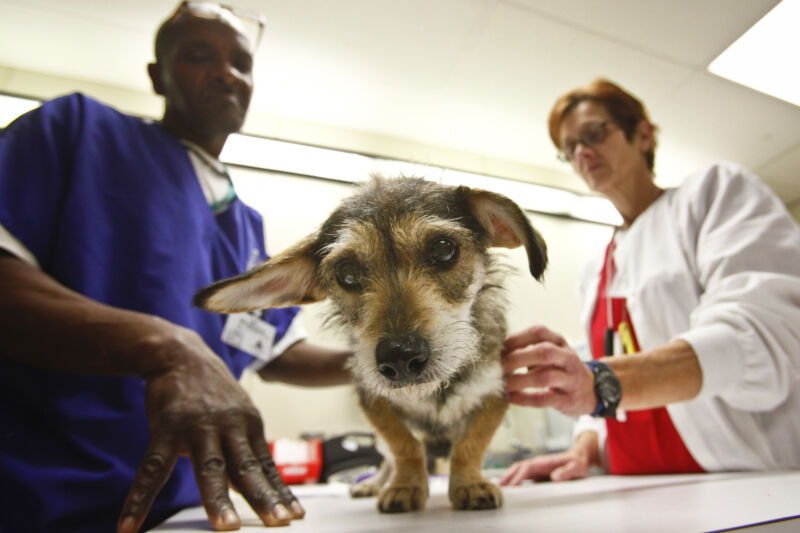
Two separately owned dogs in New Jersey tested positive last year for a dreaded, extensively drug resistant bacterial strain spread in the US by contaminated artificial eye drops manufactured in India. Those drops caused a deadly multi-state outbreak in humans over many months last year, with at least 81 people ultimately infected across 18 states. Fourteen people lost their vision, an additional four had eyeballs surgically removed, and four people died.
The preliminary data on the dogs—presented recently at a conference of disease detectives hosted by the Centers for Disease Control and Prevention—highlights that now that the deadly outbreak strain has been introduced around the US, it has the potential to lurk in unexpected places, spread its drug resistance to fellow bacteria, and cause new infections in people and animals who may have never used the drops.
The two dogs in New Jersey were not known to have received the drops linked to the outbreak: EzriCare Artificial Tears and two additional products made by the same manufacturer, which were recalled in February of 2023. Such over-the-counter products are sometimes used in animals as well as people. But the dogs’ separate owners said they didn’t recall using the drops either. They also didn’t report any exposures in health care settings or recent international travel that could explain the infections. One of the dogs did, at one point, receive eye drops, but they were not an outbreak-associated brand. The only connection between the two dogs was that they were both treated at the same veterinary hospital, which didn’t stock the outbreak-associated eyedrops.
The dogs’ infections were caught between March and June of 2023 when clinicians at the veterinary hospital were working to address a chronic cough in one of the dogs and a stubborn ear infection in the other, according to CBS News, who was present for the CDC’s conference of its Epidemic Intelligence Service in Atlanta. The ear and lung swabs were sent to an academic veterinary laboratory in Pennsylvania where a microbiologist noticed that bacteria from both swabs had uncommon drug resistance features. The microbiologist then uploaded genetic sequences of the bacterial strains to a national database, where they caught the attention of the CDC and state health authorities.
The genetic sequences uploaded were of the carbapenemase-producing carbapenem-resistant Pseudomonas aeruginosa (CP-CRPA) strain—and they were highly similar to the bacterial strain identified in the deadly eyedrop outbreak. These bacteria are extensively resistant to antibiotics, resisting even last-line drugs, and can silently colonize animals and humans for months or years. An investigation ensued.
Infection gaps
Emma Price, the CDC epidemic intelligence service officer who presented the investigation’s findings at the conference, suggested it was fortunate they were able to make the connection. “Because [the academic veterinary laboratory] had a grant and a veterinary microbiologist works there, he did his great due diligence and uploaded the results. That’s how we got the notification, because the strain matched the outbreak strain,” Price told CBS News.
But, the disease detectives were ultimately unable to identify how exactly the two dogs became infected. “Shared exposures included treatment in the veterinary hospital’s surgical preparation and recovery areas for both canines and ophthalmology department visits by either the affected canine or another animal in the same household,” Price and colleagues wrote in their findings. But all of the sampling done of the veterinary hospital where the dogs were treated turned up negative for the eyedrop outbreak strain.
In the process of the investigation, the epidemiologists also conducted an infection control assessment of the veterinary hospital, finding a variety of “gaps.” These included problems with hand hygiene practices, personal protective equipment use—including use of gloves—and equipment and environmental cleaning and disinfection at the hospital. Price noted that these problems are not uncommon and that there is a general lack of emphasis on infection control in veterinary settings.
Though Price and her colleagues were unable to identify the direct route of infection, they suspect the dogs were likely infected either by exposure to a contaminated product or secondary transmission at the veterinary hospital.
Both dogs have since made full recoveries, but because CRPA strains can silently colonize many body sites on both humans and animals, it’s possible that the bacteria still linger on the dogs or on the other pets and people in their households. Price warned the owners of possible future transmission and recommended they flag this risk to their health care providers. She also noted the potential for the bacteria to spread from dog to dog. It would be ideal to “keep the dogs away from other dogs in the future, which we understand is a difficult thing to do,” she said.




















+ There are no comments
Add yours